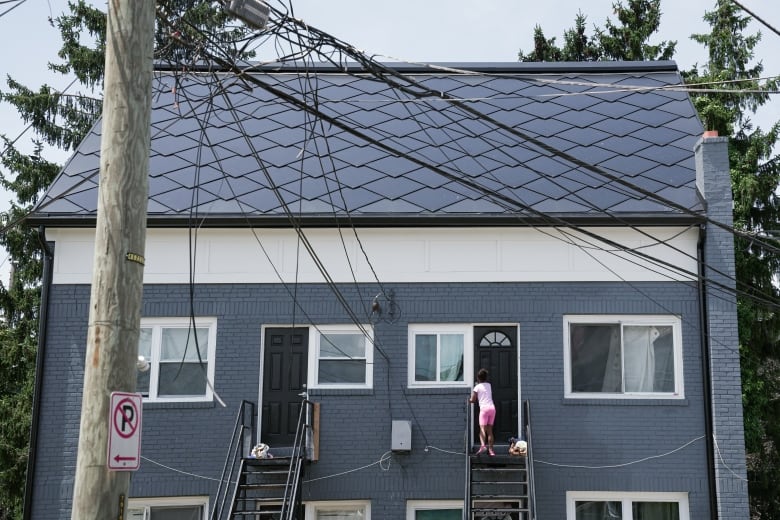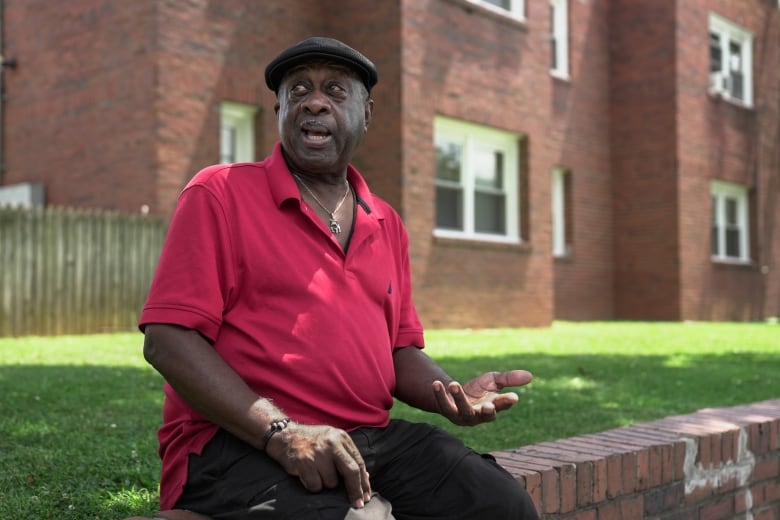Can ‘green banks’ bring clean energy to the masses? The U.S. is betting $27B on it | CBC News
You’ve heard of the gold rush? Get ready for the green rush. With close to $370 billion US ($475 billion Cdn) on the table, the race will soon be on south of the border to secure some of the clean-energy cash expected to flow out of the Inflation Reduction Act which Democrats hope to pass this coming week.
“Green banks” are one way that the Biden administration intends to distribute the billions of dollars that are meant to accelerate the adoption of solar, wind, geothermal and other forms of renewable energy.
They are quasi-public entities that aim to attract private investment to small-scale green energy projects, such as residential solar installations, energy-efficient building retrofits and various forms of electrification.
They have existed at the state and local levels in the U.S., Australia and elsewhere for more than a decade. Canada plans to spend $15 billion over three years on its own iteration, known as the Growth Fund. The Canada Infrastructure Bank is a similar public-private initiative but has a much broader mandate and has been criticized for failing to attract sufficient investment and incentivizing the privatization of public services.

The proposed U.S. legislation is expected to allocate $7 billion US to state green banks and $20 billion to a national green bank, with $8 billion of that earmarked for low- to medium-income communities.
“One of their strengths is that they’re mission-driven to care about deploying clean energy,” said William Barber III of the Coalition for Green Capital, a non-profit group that advocates on behalf of green banks.
They try to “de-risk” investments and reduce the initial cost of financing projects in order to bring more of them online faster with an eye to helping governments meet their emissions-reduction targets.
Assuming the risk
“We take a little bit more of a risk position in order for the lender to feel a little bit more comfortable,” said Tom Deyo, CEO of Montgomery County Green Bank in Rockville, Md., one of about 22 green banks in the U.S.
One reason green banks can do that, says Deyo, is that they know how to value the future energy savings a project will generate and factor that into the financing.
“Maybe they [conventional banks] can’t quite understand how energy savings are going to play out,” he said. “We’re willing to take that risk position because we know that that’s what will materialize.”

Green banks use so-called credit enhancements such as loan guarantees, loan-loss reserves or lower interest rates to help companies and residents access the loans they need to get projects up and running.
“They’re able to be more flexible in what they count towards credit worthiness or towards underwriting, and they can come up with products that serve communities in unconventional ways,” said Sandra Purohi, director of federal advocacy for E2, or Environmental Entrepreneurs, which represents green businesses and investors.
When they do put capital into a project, they expect to be repaid. They are non-profit, but they’re not a granting agency and are not meant to replace other incentives such as tax credits or rebates.
WATCH | Inflation act would include EV tax credits:
Canadian automakers breathed a sigh of relief after a U.S. climate bill that would have seen consumer tax credits for American-made electric vehicles expanded to include North American-produced EVs, batteries and critical minerals.
Banking on future energy savings
Montgomery County Green Bank was set up about seven years ago with an injection of $18 million in government funding and today is financed through an annual allocation of 10 per cent of Maryland’s gas tax.
One of the projects it funded was a $1.5-million refurbishment of a 233-unit condominium building in Takoma Park.
The homeowners association had trouble getting a bank loan to finance the kind of energy-efficient upgrades it wanted, so it approached the green bank, which eventually lent them $1.2 million in partnership with two community banks, and the condo board put in the rest.

“Condo associations have very limited ability to borrow from conventional banks,” said Tim Judson, the president of the condo board, who oversaw the project, “because the condo association doesn’t actually own property that can be collateralised the way that you collateralise your home or your condominium when you take out a mortgage.”
The board was able to put in an energy-efficient boiler, more efficient thermostats and a small natural gas heat and power system that supplies some of its electricity and helps heat the boilers and water tanks.
The bank estimated the upgrades would generate around $70,000 in energy savings, and Judson says they’ve already reached more than $90,000 a year into the project. The building went from being in the 50th percentile in terms of efficiency to sixth, he said.
“We’re more efficient than 94 per cent of buildings in the country,” said Judson, 51, who now lives in Syracuse, N.Y., but retains a unit in the building and still heads the board.

When electricity prices spiked earlier this year, their new heat and power system enabled them to generate more of their electricity in-house at a lower cost than they could buy it from the utility.
“The property is the one that gets the long-term benefit,” said Deyo. “It takes seven years to pay off that loan, and from there forward, and these systems last a lot longer than that … you see that return to yourselves as your operating costs go down.”
Technical expertise
Part of what green banks say they bring to the table is staff with the technical know-how to assess the viability of projects. That was something that attracted the D.C. solar contractor Flywheel Development when it went through D.C. Green Bank to finance a solar roof on a rental building in a low-income neighbourhood in the city’s northwest.
“Their base level of knowledge is just so much higher,” said Flywheel’s co-founder Jessica Pitts. “Lenders that we’ve approached have had much less institutional knowledge in terms of the basics of how do you even fund solar … what are your sources of income and how does it even work?”
The project cost about $132,500, with the green bank kicking in $80,000, the company $26,000 and a city renewable energy program providing the rest. A private lender and the green bank will co-finance the long-term loan that enables Flywheel to oversee the project for the length of the 15-year contract it has with the city and the property owner.
The roof will produce an average of 25,000 kilowatt hours per year, enough to supply six households. In this case, the households it’s supplying are not actually in the building. The electricity generated is fed into the city’s grid and allocated to low- and moderate-income residents through a program called Solar for All that covers half their utility bill.
Flywheel makes its money back by selling the electricity to the city and through solar energy credits, which sell for about $365 to $435 per megawatt hour in D.C., where utilities have to generate 10 per cent of their power from local solar sources by 2041.

Neighbour eyes solar with skepticism
Lorenzo Barnes, 70, has lived in the area where Flywheel installed the solar roof for 25 years and watched it go up from his apartment next door.
“There’s never been a building over here that’s had that,” he said.

He and one resident in the building who was home when CBC visited eyed the project skeptically and said they wished the property owner would use some of the benefits he’s getting from leasing out the roof space to better maintain the property.
“Who would know that this is a model project?” Barnes said, pointing to trash bins in the front yard. “People would come see it more if it was better kept up.”
National scope would allow scaling up
Solar makes up a large part of what green banks fund, spanning everything from residential roofs to farmers’ fields and church properties, the kind of projects that can have trouble attracting private capital, which tends to favour large-scale solar generation.
“That’s financed all day long,” said Pitts, referring to what’s known as utility-scale solar. “But oftentimes that market doesn’t overlap with the community-scale installations that we’re doing.”

Skeptics say projects that are truly viable should be able to be financed through conventional banks, but proponents argue they bring investment into communities that don’t usually attract green energy projects despite bearing the brunt of pollution and environmental degradation.
“These disadvantaged areas, the lower to moderate income or BIPOC areas, are often the areas that need the most in terms of upfront assistance to see clean energy project deployment,” said Barber.
Green banks’ reliance on government funding, however, does leave them vulnerable. The country’s first green bank in Connecticut had to restructure itself after a budget crisis forced the state to cut its funding and began issuing bonds to raise capital. The U.K. sold off its green bank five years after creating it and came under criticism for losing sight of its mandate.
WATCH | Britons struggle to adapt to unprecedented heat:
Britain recorded its highest temperature ever Tuesday after the heat rose above 40 C. The extreme heat is already raising questions about how the country should prepare for a warmer future.
If a national green bank goes ahead, it would allow for a broader scope of projects than state banks can currently finance, say proponents, including things such as installing transmission lines across state lines or in remote communities.
“We have a limited window in which we have to do an inordinate amount of investment in clean energy,” said Barber. “We are talking a massive opportunity to scale electrification, and so a national green bank would allow us to do that.”
For all the latest business News Click Here



